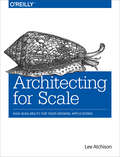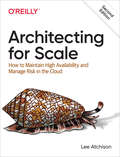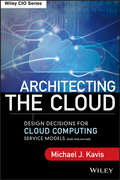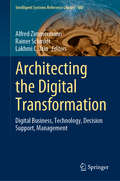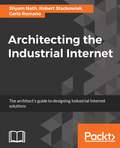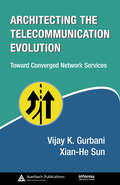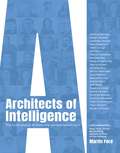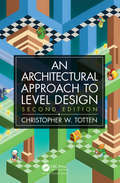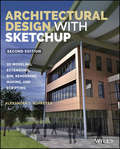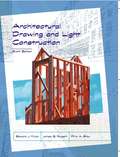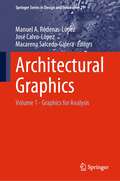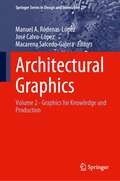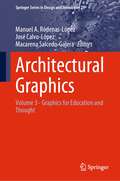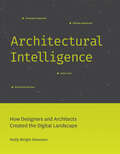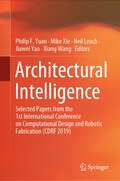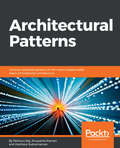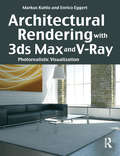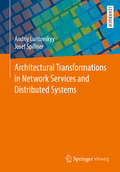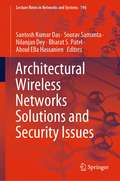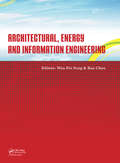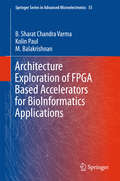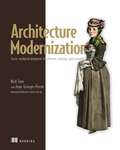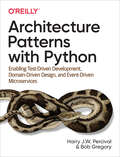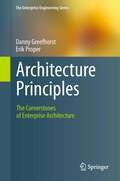- Table View
- List View
Architecting for Scale: High Availability for Your Growing Applications
by Lee AtchisonEvery day, companies struggle to scale critical applications. As traffic volume and data demands increase, these applications become more complicated and brittle, exposing risks and compromising availability. This practical guide shows IT, devops, and system reliability managers how to prevent an application from becoming slow, inconsistent, or downright unavailable as it grows.Scaling isn't just about handling more users; it's also about managing risk and ensuring availability. Author Lee Atchison provides basic techniques for building applications that can handle huge quantities of traffic, data, and demand without affecting the quality your customers expect.In five parts, this book explores:Availability: learn techniques for building highly available applications, and for tracking and improving availability going forwardRisk management: identify, mitigate, and manage risks in your application, test your recovery/disaster plans, and build out systems that contain fewer risksServices and microservices: understand the value of services for building complicated applications that need to operate at higher scaleScaling applications: assign services to specific teams, label the criticalness of each service, and devise failure scenarios and recovery plansCloud services: understand the structure of cloud-based services, resource allocation, and service distribution
Architecting for Scale: How to Maintain High Availability and Manage Risk in the Cloud
by Lee AtchisonEvery day, companies struggle to scale critical applications. As traffic volume and data demands increase, these applications become more complicated and brittle, exposing risks and compromising availability. With the popularity of software as a service, scaling has never been more important.Updated with an expanded focus on modern architecture paradigms such as microservices and cloud computing, this practical guide provides techniques for building systems that can handle huge quantities of traffic, data, and demand—without affecting the quality your customers expect. Architects, managers, and directors in engineering and operations organizations will learn how to build applications at scale that run more smoothly and reliably to meet the needs of customers.Learn how scaling affects the availability of your services, why that matters, and how to improve itDive into a modern service-based application architecture that ensures high availability and reduces the effects of service failuresExplore the Single Team Owned Service Architecture paradigm (STOSA)—a model for scaling your development organization in tandem with your applicationUnderstand, measure, and mitigate risk in your systemsUse the cloud to build highly scalable applications
Architecting the Cloud
by Michael J. KavisAn expert guide to selecting the right cloud service model for your businessCloud computing is all the rage, allowing for the delivery of computing and storage capacity to a diverse community of end-recipients. However, before you can decide on a cloud model, you need to determine what the ideal cloud service model is for your business. Helping you cut through all the haze, Architecting the Cloud is vendor neutral and guides you in making one of the most critical technology decisions that you will face: selecting the right cloud service model(s) based on a combination of both business and technology requirements.Guides corporations through key cloud design considerationsDiscusses the pros and cons of each cloud service modelHighlights major design considerations in areas such as security, data privacy, logging, data storage, SLA monitoring, and moreClearly defines the services cloud providers offer for each service model and the cloud services IT must provideArming you with the information you need to choose the right cloud service provider, Architecting the Cloud is a comprehensive guide covering everything you need to be aware of in selecting the right cloud service model for you.
Architecting the Digital Transformation: Digital Business, Technology, Decision Support, Management (Intelligent Systems Reference Library #188)
by Lakhmi C. Jain Rainer Schmidt Alfred ZimmermannThis research-oriented book presents key contributions on architecting the digital transformation. It includes the following main sections covering 20 chapters: · Digital Transformation · Digital Business · Digital Architecture · Decision Support · Digital Applications Focusing on digital architectures for smart digital products and services, it is a valuable resource for researchers, doctoral students, postgraduates, graduates, undergraduates, academics and practitioners interested in digital transformation.
Architecting the Industrial Internet
by Robert Stackowiak Shyam Nath Carla RomanoLearn the ins and outs of the Industrial Internet of Things through subjects ranging from its history and evolution, right up to what the future holds. About This Book • Define solutions that can connect existing systems and newer cloud-based solutions to thousands of thousands of edge devices and industrial machines • Identify, define, and justify Industrial Internet of Things (IIoT) projects, and design an application that can connect to and control thousands of machines • Leverage the power and features of a platform to monitor, perform analytics, and maintain the Industrial Internet Who This Book Is For Architects who are interested in learning how to define solutions for the Industrial Internet will benefit immensely from this book. Relevant architect roles include enterprise architects, business architects, information architects, cloud solution architects, software architects, and others. The content is also relevant for technically inclined line of business leaders investing in these solutions. What You Will Learn • Learn the history of the Industrial Internet and why an architectural approach is needed • Define solutions that can connect to and control thousands of edge devices and machines • Understand the significance of working with line of business leadership and key metrics to be gathered • Connect business requirements to the functional architecture • Gain the right expectation as to the capabilities of Industrial Internet applications and how to assess them • Understand what data and analytics components should be included in your architecture solution • Understand deployment trade-offs, management and security considerations, and the impact of emerging technologies In Detail The Industrial Internet or the IIoT has gained a lot of traction. Many leading companies are driving this revolution by connecting smart edge devices to cloud-based analysis platforms and solving their business challenges in new ways. To ensure a smooth integration of such machines and devices, sound architecture strategies based on accepted principles, best practices, and lessons learned must be applied. This book begins by providing a bird's eye view of what the IIoT is and how the industrial revolution has evolved into embracing this technology. It then describes architectural approaches for success, gathering business requirements, and mapping requirements into functional solutions. In a later chapter, many other potential use cases are introduced including those in manufacturing and specific examples in predictive maintenance, asset tracking and handling, and environmental impact and abatement. The book concludes by exploring evolving technologies that will impact IIoT architecture in the future and discusses possible societal implications of the Industrial Internet and perceptions regarding these projects. By the end of this book, you will be better equipped to embrace the benefits of the burgeoning IIoT. Style and approach This book takes a comprehensive approach to the Industrial Internet, thoroughly acquainting the reader with the concepts and philosophy of the IIoT. It provides a basis for defining an IIoT solution in a thoughtful manner and creating what will be viewed as a successful project.
Architecting the Telecommunication Evolution: Toward Converged Network Services (Informa Telecoms & Media)
by Xian-He Sun Vijay K. GurbaniService-oriented architecture (SOA) uses services as the baseline for developing new architectures and applications, as networks are built specifically to satisfy service requirements. Most services are currently handled over different networks, but newer services will soon require cross-network support. Architecting the Telecommunication Evolution
Architects of Intelligence: The truth about AI from the people building it
by Martin FordFinancial Times Best Books of the Year 2018 TechRepublic Top Books Every Techie Should Read Book Description How will AI evolve and what major innovations are on the horizon? What will its impact be on the job market, economy, and society? What is the path toward human-level machine intelligence? What should we be concerned about as artificial intelligence advances? Architects of Intelligence contains a series of in-depth, one-to-one interviews where New York Times bestselling author, Martin Ford, uncovers the truth behind these questions from some of the brightest minds in the Artificial Intelligence community. Martin has wide-ranging conversations with twenty-three of the world's foremost researchers and entrepreneurs working in AI and robotics: Demis Hassabis (DeepMind), Ray Kurzweil (Google), Geoffrey Hinton (Univ. of Toronto and Google), Rodney Brooks (Rethink Robotics), Yann LeCun (Facebook) , Fei-Fei Li (Stanford and Google), Yoshua Bengio (Univ. of Montreal), Andrew Ng (AI Fund), Daphne Koller (Stanford), Stuart Russell (UC Berkeley), Nick Bostrom (Univ. of Oxford), Barbara Grosz (Harvard), David Ferrucci (Elemental Cognition), James Manyika (McKinsey), Judea Pearl (UCLA), Josh Tenenbaum (MIT), Rana el Kaliouby (Affectiva), Daniela Rus (MIT), Jeff Dean (Google), Cynthia Breazeal (MIT), Oren Etzioni (Allen Institute for AI), Gary Marcus (NYU), and Bryan Johnson (Kernel). Martin Ford is a prominent futurist, and author of Financial Times Business Book of the Year, Rise of the Robots. He speaks at conferences and companies around the world on what AI and automation might mean for the future. Meet the minds behind the AI superpowers as they discuss the science, business and ethics of modern artificial intelligence. Read James Manyika's thoughts on AI analytics, Geoffrey Hinton's breakthroughs in AI programming and development, and Rana el Kaliouby's insights into AI marketing. This AI book collects the opinions of the luminaries of the AI business, such as Stuart Russell (coauthor of the leading AI textbook), Rodney Brooks (a leader in AI robotics), Demis Hassabis (chess prodigy and mind behind AlphaGo), and Yoshua Bengio (leader in deep learning) to complete your AI education and give you an AI advantage in 2019 and the future.
Architectural Approach to Level Design: Second edition
by Christopher TottenWritten by a game developer and professor trained in architecture, An Architectural Approach to Level Design is one of the first books to integrate architectural and spatial design theory with the field of level design. It explores the principles of level design through the context and history of architecture. Now in its second edition, An Architectural Approach to Level Design presents architectural techniques and theories for you to use in your own work. The author connects architecture and level design in different ways that address the practical elements of how designers construct space and the experiential elements of how and why humans interact with that space. It also addresses industry issues like how to build interesting tutorial levels and how to use computer-generated level design systems without losing the player-focused design of handmade levels. Throughout the text, you will learn skills for spatial layout, evoking emotion through gamespaces, and creating better levels through architectural theory. FEATURES Presents case studies that offer insight on modern level design practices, methods, and tools Presents perspectives from industry designers, independent game developers, scientists, psychologists, and academics Explores how historical structures can teach us about good level design Shows how to use space to guide or elicit emotion from players Includes chapter exercises that encourage you to use principles from the chapter in digital prototypes, playtesting sessions, paper mock-ups, and design journals Bringing together topics in game design and architecture, this book helps you create better spaces for your games. Software independent, the book discusses tools and techniques that you can use in crafting your interactive worlds.
Architectural Design with SketchUp
by Alexander C. SchreyerGo beyond the basics: making SketchUp work for you Architectural Design with SketchUp, Second Edition, is the leading guide to this incredibly useful tool for architects, interior designers, construction professionals, and makers. With easy to follow tutorials that first brush up on the basics of the program and then cover many advanced processes, this resource offers both informative text and full-color illustrations to clearly convey the techniques and features you need to excel. The updated second edition has a new chapter that explains how to make things with SketchUp, and covers 3D printing, design to fabrication, CNC milling, and laser cutting. Other chapters also now cover Building Information Modeling (BIM) and 3D web content generation. Additionally, the revised text offers insight into the latest products and plugin extensions, navigation methods, import/export options, and 3D model creation features to ensure you have an up to date understanding of how to make SketchUp help you meet your project goals. A leading 3D modeling application, SketchUp features documentation capabilities through photorealistic renderings and construction drawings. Because of its ease of use and ability to be enhanced with many plugin extensions for project-specific applications, SketchUp is considered the tool of choice for professionals in the architecture, interior design, construction, and fabrication fields. Access thoroughly updated information in an easy to understand writing style Increase your efficiency and accuracy when using SketchUp and refresh and supplement your understanding of SketchUp's basics Explore component-based modeling for assembly, scheduling, collaborative design, and modeling with a BIM approach Find the right plugin extensions and understand how to best work with them See how easy it is to generate presentation-ready renderings from your 3D models Learn how you can use 3D printing, CNC milling, and laser cutting to make things with SketchUp Use cookbook-style Ruby coding to create amazing 3D objects Supplement your knowledge with video tutorials, sample files, and Ruby scripts via a robust companion website Architectural Design with SketchUp, Second Edition, is an integral resource for both students and professionals working in the architecture, interior design, construction, and fabrication industries.
Architectural Drawing and Light Construction (6th Edition)
by Edward John Muller James G. Fausett Philip A. GrauUsing clear, concise explanations and numerous illustrations, this book introduces the basics of architectural design and practice along with construction documentation and practice. This book provides the most current information on architecture and construction including modern residential planning, environmental considerations, computer-aided design and drafting, building codes, and lettering.
Architectural Graphics: Volume 1 - Graphics for Analysis (Springer Series in Design and Innovation #21)
by José Calvo-López Manuel A. Ródenas-López Macarena Salcedo-GaleraThis book reports on several advances in architectural graphics, with a special emphasis on education, training, and research. It gathers a selection of contributions to the 19th International Conference on Graphic Design in Architecture, EGA 2022, held on June 2–4, 2022, in Cartagena, Spain, with the motto: "Beyond drawings. The use of architectural graphics".
Architectural Graphics: Volume 2 - Graphics for Knowledge and Production (Springer Series in Design and Innovation #22)
by José Calvo-López Manuel A. Ródenas-López Macarena Salcedo-GaleraThis book reports on several advances in architectural graphics, with a special emphasis on education, training and research. It gathers a selection of contributions to the 19th International Conference on Graphic Design in Architecture, EGA 2022, held on June 2–4, 2022, in Cartagena, Spain, with the motto: "Beyond drawings. The use of architectural graphics".
Architectural Graphics: Volume 3 - Graphics for Education and Thought (Springer Series in Design and Innovation #23)
by José Calvo-López Manuel A. Ródenas-López Macarena Salcedo-GaleraThis book reports on several advances in architectural graphics, with a special emphasis on education, training and research. It gathers a selection of contributions to the 19th International Conference on Graphic Design in Architecture, EGA 2022, held on June 2–4, 2022, in Cartagena, Spain, with the motto: "Beyond drawings. The use of architectural graphics".
Architectural Intelligence: How Designers and Architects Created the Digital Landscape (The\mit Press Ser.)
by Molly Wright SteensonArchitects who engaged with cybernetics, artificial intelligence, and other technologies poured the foundation for digital interactivity.In Architectural Intelligence, Molly Wright Steenson explores the work of four architects in the 1960s and 1970s who incorporated elements of interactivity into their work. Christopher Alexander, Richard Saul Wurman, Cedric Price, and Nicholas Negroponte and the MIT Architecture Machine Group all incorporated technologies—including cybernetics and artificial intelligence—into their work and influenced digital design practices from the late 1980s to the present day. Alexander, long before his famous 1977 book A Pattern Language, used computation and structure to visualize design problems; Wurman popularized the notion of “information architecture”; Price designed some of the first intelligent buildings; and Negroponte experimented with the ways people experience artificial intelligence, even at architectural scale. Steenson investigates how these architects pushed the boundaries of architecture—and how their technological experiments pushed the boundaries of technology. What did computational, cybernetic, and artificial intelligence researchers have to gain by engaging with architects and architectural problems? And what was this new space that emerged within these collaborations? At times, Steenson writes, the architects in this book characterized themselves as anti-architects and their work as anti-architecture. The projects Steenson examines mostly did not result in constructed buildings, but rather in design processes and tools, computer programs, interfaces, digital environments. Alexander, Wurman, Price, and Negroponte laid the foundation for many of our contemporary interactive practices, from information architecture to interaction design, from machine learning to smart cities.
Architectural Intelligence: Selected Papers from the 1st International Conference on Computational Design and Robotic Fabrication (CDRF 2019)
by Neil Leach Philip F. Yuan Jiawei Yao Mike Xie Xiang WangThis book presents selected papers from The 1st International Conference on Computational Design and Robotic Fabrication (CDRF 2019). Focusing on novel architecture theories, tools, methods, and procedures for digital design and construction in architecture, it promotes dialogs between architecture, engineer, computer science, robotics, and other relevant disciplines to establish a new way of production in the building industry in the digital age. The contents make valuable contributions to academic researchers and engineers in the industry. At the same time, it offers readers new ideas for the application of digital technology.
Architectural Patterns: Uncover essential patterns in the most indispensable realm of enterprise architecture
by Pethuru Raj Chelliah Harihara Subramanian J Anupama Murali Dr Kayarvizhy NKey Features Use patterns to tackle communication, integration, application structure, and more Implement modern design patterns such as microservices to build resilient and highly available applications Choose between the MVP, MVC, and MVVM patterns depending on the application being built Book Description Enterprise Architecture (EA) is typically an aggregate of the business, application, data, and infrastructure architectures of any forward-looking enterprise. Due to constant changes and rising complexities in the business and technology landscapes, producing sophisticated architectures is on the rise. Architectural patterns are gaining a lot of attention these days. The book is divided in three modules. You'll learn about the patterns associated with object-oriented, component-based, client-server, and cloud architectures. The second module covers Enterprise Application Integration (EAI) patterns and how they are architected using various tools and patterns. You will come across patterns for Service-Oriented Architecture (SOA), Event-Driven Architecture (EDA), Resource-Oriented Architecture (ROA), big data analytics architecture, and Microservices Architecture (MSA). The final module talks about advanced topics such as Docker containers, high performance, and reliable application architectures. The key takeaways include understanding what architectures are, why they're used, and how and where architecture, design, and integration patterns are being leveraged to build better and bigger systems. What you will learn Understand how several architectural and design patterns work to systematically develop multitier web, mobile, embedded, and cloud applications Learn object-oriented and component-based software engineering principles and patterns Explore the frameworks corresponding to various architectural patterns Implement domain-driven, test-driven, and behavior-driven methodologies Deploy key platforms and tools effectively to enable EA design and solutioning Implement various patterns designed for the cloud paradigm
Architectural Photography
by Adrian SchulzArchitectural photography is more than simply choosing a subject and pressing the shutter-release button; it's more than just documenting a project. An architectural photograph shows the form and appeal of a building far better than any other medium. With the advent of the digital photographic workflow, architects are discovering exciting new opportunities to present and market their work. But what are the ingredients for a successful architectural photograph? What equipment do you need? How can you improve your images in your digital darkroom? Why does a building look different in reality than in a photographic image? In this book you will find the answers to these questions and much more. Author Adrian Schulz-both an architect and a photographer by training-uses real-world projects to teach you how to: Capture outstanding images of buildings, inside and out Choose the right equipment and use it effectively Compose architectural shots Work with ambient and artificial light Process images in an efficient workflow based on Adobe Photoshop This book is a step-by-step guide to architectural photography for both the aspiring amateur photographer interested in architectural photography and the professional photographer wanting to expand his skills in this domain. Moreover, architects themselves will find this book motivating and inspiring. This second edition has been extensively revised and includes 80 new images and illustrations, as well as an expanded chapter on shooting interior spaces. Also included is an updated discussion of post-processing techniques and the latest technical developments in the world of photography. With this book, you will learn a variety of creative tips, tricks, and guidelines for making the perfect architectural image.
Architectural Rendering with 3ds Max and V-Ray: Photorealistic Visualization
by Markus KuhloCreate high-quality photorealistic renders of architectural visualizations using 3ds Max and Vray with the project-based tutorials in this book. Learn how to combine lighting and rendering options to end-up with the most realistic final renders possible at a professional level. The tutorials in this book are filled with beautiful full-color images and they teach you how to light both interiors and exteriors and daytime and nighttime scenes. Learn how to save time without sacrificing the quality of your final renders with tips and tricks on rendering with Vray - the most accurate rendering application for 3ds Max. The companion CD includes all the project files that you need to recreate each of the projects presented within the book.
Architectural Transformations in Network Services and Distributed Systems
by Andriy Luntovskyy Josef SpillnerWith the given work we decided to help not only the readers but ourselves, as the professionals who actively involved in the networking branch, with understanding the trends that have developed in recent two decades in distributed systems and networks. Important architecture transformations of distributed systems have been examined. The examples of new architectural solutions are discussed.
Architectural Wireless Networks Solutions and Security Issues (Lecture Notes in Networks and Systems #196)
by Aboul Ella Hassanien Nilanjan Dey Santosh Kumar Das Sourav Samanta Bharat S. PatelThis book presents architectural solutions of wireless network and its variations. It basically deals with modeling, analysis, design and enhancement of different architectural parts of wireless network. The main aim of this book is to enhance the applications of wireless network by reducing and controlling its architectural issues. The book discusses efficiency and robustness of wireless network as a platform for communication and data transmission and also discusses some challenges and security issues such as limited hardware resources, unreliable communication, dynamic topology of some wireless networks, vulnerability and unsecure environment. This book is edited for users, academicians and researchers of wireless network. Broadly, topics include modeling of security enhancements, optimization model for network lifetime, modeling of aggregation systems and analyzing of troubleshooting techniques.
Architectural, Energy and Information Engineering: Proceedings of the 2015 International Conference on Architectural, Energy and Information Engineering (AEIE 2015), Xiamen, China, May 19-20, 2015
by Ran Chen Wen-Pei SungThis proceedings volume brings together selected peer-reviewed papers presented at the 2015 International Conference on Architectural, Energy and Information Engineering (AEIE 2015), held July 15-16, 2015 in Hong Kong, China. The proceedings are divided into two parts, Architectural, Energy and Environmental Engineering and Information Enginee
Architecture Exploration of FPGA Based Accelerators for BioInformatics Applications (Springer Series in Advanced Microelectronics #55)
by B. Sharat Chandra Varma Kolin Paul M. BalakrishnanThis book presents an evaluation methodology to design future FPGA fabrics incorporating hard embedded blocks (HEBs) to accelerate applications. This methodology will be useful for selection of blocks to be embedded into the fabric and for evaluating the performance gain that can be achieved by such an embedding. The authors illustrate the use of their methodology by studying the impact of HEBs on two important bioinformatics applications: protein docking and genome assembly. The book also explains how the respective HEBs are designed and how hardware implementation of the application is done using these HEBs. It shows that significant speedups can be achieved over pure software implementations by using such FPGA-based accelerators. The methodology presented in this book may also be used for designing HEBs for accelerating software implementations in other domains besides bioinformatics. This book will prove useful to students, researchers, and practicing engineers alike.
Architecture Modernization: Socio-technical alignment of software, strategy, and structure
by Nick Tune Jean-Georges PerrinProven techniques and principles for modernizing legacy systems into new architectures that deliver serious competitive advantage.For a business to thrive, it needs a modern software architecture that is aligned with its corporate architecture. This book presents concrete practices that sync software, product, strategy, team dynamics, and work practices. You&’ll evolve your technical and social architecture together, reducing needless dependencies and achieving faster flow of innovation across your organization. In Architecture Modernization: Socio-technical alignment of software, strategy, and structure you&’ll learn how to: Identify strategic ambitions and challenges using listening and mapping tours Visualize your business landscape and crucial capabilities with Wardley Mapping Create a product taxonomy as a framework for your architecture Run big picture EventStorming workshops to map business domains Apply Team Topologies patterns to identify and refine value streams Design loosely coupled, domain-aligned software architectures Build internal developer platforms for rapid, reliable evolution Implement data mesh principles and tools to revolutionize data engineering Deliver compelling modernization roadmaps focused on continuous value Architecture Modernization: Socio-technical alignment of software, strategy, and structure shows you how to turn the practice of architecting systems into a transformative process for your entire company. Chapter-by-chapter, you&’ll identify the reasons and benefits of modernization, design an architecture that works for your business, and then implement your new approach in a progressive and sustainable manner. Every technique is illustrated with insightful industry examples and an interactive Miro board that lets you dig deeper. Forewords by Matthew Skelton and Xin Yao. About the technology The decisions you make about your software are inherently connected to the decisions you make about your business. Why not turn the mundane task of modernizing legacy systems into a transformative process for your entire company? This book shows you how! It reveals a socio-technical approach to align your software and products with organizational dynamics and ways of working. About the book Architecture Modernization: Socio-technical alignment of software, strategy, and structure presents a clear path for upgrading your entire organization when you re-imagine your software. In it, you&’ll learn to combine practices like Domain-Driven Design, Event Storming, and Wardley Mapping to discover user needs, design optimal architecture, and avoid falling back into old habits. Provocative examples from Danske, Salesforce, the UK Government, and others show the real-world result of each approach, identifying techniques you can apply effectively in your own business. About the reader For CTOs, tech leads, and principal engineers who decide on architecture and organization design. About the author Nick Tune helps organizations modernize their architectures through empowered product teams and continuous delivery. Jean-Georges Perrin builds innovative and modern data platforms. The technical editor on this book was Kamil Nicieja.
Architecture Patterns with Python: Enabling Test-Driven Development, Domain-Driven Design, and Event-Driven Microservices
by Harry Percival Bob GregoryAs Python continues to grow in popularity, projects are becoming larger and more complex. Many Python developers are taking an interest in high-level software design patterns such as hexagonal/clean architecture, event-driven architecture, and the strategic patterns prescribed by domain-driven design (DDD). But translating those patterns into Python isn’t always straightforward.With this hands-on guide, Harry Percival and Bob Gregory from MADE.com introduce proven architectural design patterns to help Python developers manage application complexity—and get the most value out of their test suites. Each pattern is illustrated with concrete examples in beautiful, idiomatic Python, avoiding some of the verbosity of Java and C# syntax. Patterns include:Dependency inversion and its links to ports and adapters (hexagonal/clean architecture)Domain-driven design’s distinction between Entities, Value Objects, and Aggregates Repository and Unit of Work patterns for persistent storageEvents, commands, and the message busCommand-query responsibility segregation (CQRS)Event-driven architecture and reactive microservices
Architecture Principles: The Cornerstones of Enterprise Architecture (The Enterprise Engineering Series)
by Danny Greefhorst Erik ProperIt can be argued that architecture principles form the cornerstone of any architecture. The focus of this book is on the role of architecture principles. It provides both a balanced perspective on architecture principles, and is the first book on the topic.
